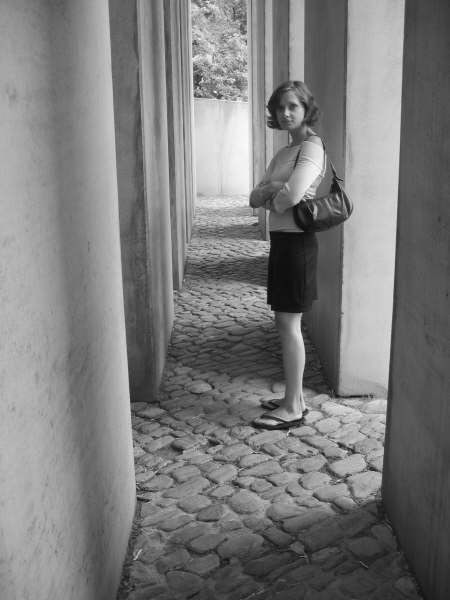In last Tuesday's Introduction to Museum Studies class, we discussed the centrality of collections in defining museums. In last Wednesday's Public History class we thought about criticism the Canadian Museum of Civilization received in its early days for seemingly favouring other elements of its presentation - such as live performances, exhibits that replicated places of the past, and some replica artifacts - over its collections of authentic artifacts.
The last museum visit I made was to the McCord. I wasn't particularly moved by the museum's Simply Montréal permanent exhibit until I saw an element that bore direct relevance to my life experience. It was stationed near the exhibit's end. It wasn't an authentic artifact that caught my eye. It was a simplified map of the city, apparently constructed (out of some kind of plywood) specifically for the exhibit. The map was colour-coded according to predominant languages spoken per area, and was fixed to a wall below a silent film clip that featured Montrealers 'on the go' in the city.
This component of the exhibit moved me because it spoke directly to my life experience. The video clip featured shots from my neighborhood. That was my hook. It didn't come from an 'authentic' historic artifact. What's more, only after that "aha!" moment did I care to pay attention to the "big idea" of the Simply Montréal exhibit. The "big idea", paraphrased, is this: Montréal is a neat city that owes its dynamism to its rich history. The McCord evinces that rich history through First Nations objects, Notman photographs, and a diverse array of everyday objects of Montrealers such as apparel, and household items.
These objects are incredibly varied. To ensure that its visitor has an "aha!" moment like mine - or to make sure that moment comes before the exhibit's end - the McCord could make its curatorial voice louder. I believe it could do this by including more teaching tools, like the map and video, in the exhibit. Without such tools, I argue, visitors may not understand the big "so what?" that links the collection.
Move over, collections! Yes, yes, you reside at the museum's core, but share the spotlight with pedagogy. I'm adding my voice to some comments my colleagues have made. They have referred to the Canadian Museum of Civilization as example. Alex has reflected on the need to balance "flashy interactives" and artifact replicas with authentic collections. Carling has insisted that collection and interpretation is what "makes a museum a museum." Additionally, I argue, it is constructive to think of pedagogy as extending beyond interpretation in the exhibit itself. We all know that funding crises plague museums. With that important reality in mind, I say that, ideally, museums' educational programming can work to effectively integrate the museum into its community.
Some things I've read the past week do a great job of articulating the need to place pedagogy at the museum's core. They all address the ways to make the museum relevant to communities today. The following ideas have inspired me to think of the museum in different ways:
1. Eilean Hooper-Greenhill argues for the museum as a "social and cultural institution." Museums can be important (and necessary, even) cultural centres. She writes of research in England that uncovered a common notion among "ethnic" communities that museums ignored Black contributions to British life because, it was thought, those museums continued a colonial view of the past. The same study, however, also confirmed that said communities thought museums could be places where Asian and Afro-Caribbean parents could meet to discuss their own cultural values. [1]
2. E.H. Gurian has argued that the essence of a museum is not objects. Rather, it is a "place that stores memories." Objects are necessary for the museum, but they are not sufficient. What people really care about is ownership of a story. They don't care about ownership of the artifact itself. [2] If museums are less object-based, artifacts are props. Again, they are essential to a museum's purpose, but only in so far as they make an exhibit's 'big idea' tangible. The foundational definition of the museum, Gurain writes, will not centre on objects, but rather on the institution as a place for storytelling "in tangible sensory form." Providing a story is to perform a community service. As such, museums are "social service providers."[3]
3. Stephen E. Weil's writing can help us think further on these kinds of ideas. While museums once focused predominantly on collections (development, research, conservation, etc.), he writes many now have shifted that focus to public service. Collections, he continues, are no longer an end in themselves. Instead, they are a means to that end. Museums should ask about each artifact's utility: "how might this object be useful to the museum in carrying out its institutional mission?" In this way, museums subordinate collections to a bigger vision of the museum's function in the community. [4]
------------------------------------------------------------------------------------
[1]. Eilean Hooper-Greenhill, Museums and the Interpretation of Visual Culture (New York: Routledge, 2000), 7.
[2]. E.H. Gurian, "What is the Object of the Exercise? A Meandering Exploration of the Many Meanings of Objects in Museums" in Gail Anderson, ed., Reinventing the Museum: Historical and Contemporary Perspectives on the Paradigm Shift (Walnut Creek: AltaMira Press, 2004), 270-1.
[3]. Gurian in Anderson, 282-3.
[4]. Stephen E. Weil, "Collecting Then, Collecting Today: What's the Difference?" in Anderson, 290.
Thursday, January 18, 2007
Subscribe to:
Post Comments (Atom)

1 comment:
Really nice post with really good info. Great blog ... many likes from stoixima
Post a Comment